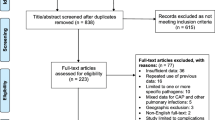Abstract
The purpose of this investigation was to describe the first application of nasopharyngeal cytology (NPC), a new cytological technique to collect cellular material from the nasopharyngeal surface non-invasively in children with chronic adenoiditis associated with recurrent acute otitis media and/or otitis media with effusion. Cellular material was collected transorally using an extra-thin flexible wire nasopharyngeal swab and then examined under a light microscope. The diagnostic accuracy of NPC in detecting the presence of allergy and pathogens (compared to microbiological evaluation of nasopharyngeal aspirates, NPAs) was assessed. NPC was performed on 121 children (mean age 69.4 ± 15.5 months). Inflammatory cells and pathogens were detected in 61.1 % and 44.2 % of patients, respectively. The specificity of nasopharyngeal eosinophils in detecting allergy was good (91.9 %), as was the specificity of mast cells, but the sensitivities were less. The NPAs revealed bacterial colonisation in 84.7 % of the patients, and Streptococcus pneumoniae was the most frequently isolated (60.0 %). NPC revealed the presence of bacteria in 94.9 % of patients, including bacillary species in 33.9 %. NPC was highly sensitive in detecting pathogens (96.0 %). Its specificity in detecting bacillary species was fairly good (75.0 %), but the corresponding values of the specificity of NPC in detecting pathogens and its sensitivity in detecting bacillary species were poor. Our findings suggest the need for more structured studies that can test the real effectiveness and usefulness of NPC in defining nasopharyngeal cytological patterns in children with chronic nasopharyngeal diseases by comparing it with established diagnostic techniques.
Similar content being viewed by others
References
Gelardi M, Luigi Marseglia G, Licari A, Landi M, Dell’Albani I, Incorvaia C, Frati F, Quaranta N (2012) Nasal cytology in children: recent advances. Ital J Pediatr 38:51
Gelardi M, Incorvaia C, Passalacqua G, Quaranta N, Frati F (2011) The classification of allergic rhinitis and its cytological correlate. Allergy 66:1624–1625
Gelardi M, Passalacqua G, Fiorella ML, Mosca A, Quaranta N (2011) Nasal cytology: the “infectious spot”, an expression of a morphological-chromatic biofilm. Eur J Clin Microbiol Infect Dis 30:1105–1109
Torretta S, Drago L, Marchisio P, Gaffuri M, Clemente IA, Pignataro L (2013) Topographic distribution of biofilm-producing bacteria in adenoid subsites of children with chronic or recurrent middle ear infections. Ann Otol Rhinol Laryngol 122:109–113
Torretta S, Marchisio P, Drago L, Baggi E, De Vecchi E, Garavello W, Nazzari E, Pignataro L, Esposito S (2012) Nasopharyngeal biofilm-producing otopathogens in children with nonsevere recurrent acute otitis media. Otolaryngol Head Neck Surg 146:991–996
Nazzari E, Torretta S, Pignataro L, Marchisio P, Esposito S (2015) Role of biofilm in children with recurrent upper respiratory tract infections. Eur J Clin Microbiol Infect Dis 34:421–429
Torretta S, Cappadona M, Cairoli D, Pignataro L (2015) Airborne nitric oxide and nasal cytology in patients with chronic rhinosinusitis and nasal polyps. J Biol Regul Homeost Agents 29:969–976
Marchisio P, Claut L, Rognoni A, Esposito S, Passali D, Bellussi L, Drago L, Pozzi G, Mannelli S, Schito G, Principi N (2003) Differences in nasopharyngeal bacterial flora in children with nonsevere recurrent acute otitis media and chronic otitis media with effusion: implications for management. Pediatr Infect Dis J 22:262–268
Syrjänen RK, Herva EE, Mäkelä PH, Puhakka HJ, Auranen KJ, Takala AK, Kilpi TM (2006) The value of nasopharyngeal culture in predicting the etiology of acute otitis media in children less than two years of age. Pediatr Infect Dis J 25:1032–1036
Author information
Authors and Affiliations
Corresponding author
Ethics declarations
Funding and conflict of interest
This project is part of a larger study sponsored by IBSA Farmaceutici Italia Srl. The Authors declare that they have no other conflict of interest.
Ethical approval
All procedures performed in studies involving human participants were in accordance with the ethical standards of the institutional research committee and with the 1964 Helsinki declaration and its later amendments or comparable ethical standards.
Informed consent
Informed consent was obtained from the parents or legal guardians of the children included in the study.
Rights and permissions
About this article
Cite this article
Torretta, S., Marchisio, P., Colombo, M.R. et al. Paediatric nasopharyngeal cytology: a new diagnostic opportunity?. Eur J Clin Microbiol Infect Dis 35, 1097–1099 (2016). https://doi.org/10.1007/s10096-016-2637-5
Received:
Accepted:
Published:
Issue Date:
DOI: https://doi.org/10.1007/s10096-016-2637-5




